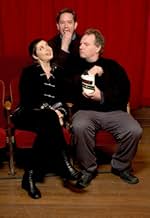CALIFICACIÓN DE IMDb
7.0/10
6.5 k
TU CALIFICACIÓN
Durante la Gran Depresión, una baronesa cervecera en Winnipeg organiza un concurso para encontrar la música más triste del mundo. Músicos de todo el orbe acuden a la ciudad para intentar gan... Leer todoDurante la Gran Depresión, una baronesa cervecera en Winnipeg organiza un concurso para encontrar la música más triste del mundo. Músicos de todo el orbe acuden a la ciudad para intentar ganar el premio de 25.000 dólares.Durante la Gran Depresión, una baronesa cervecera en Winnipeg organiza un concurso para encontrar la música más triste del mundo. Músicos de todo el orbe acuden a la ciudad para intentar ganar el premio de 25.000 dólares.
- Dirección
- Guionistas
- Elenco
- Premios
- 6 premios ganados y 7 nominaciones en total
Nancy Jane Drake
- American Mother
- (as Nancy Drake)
- Dirección
- Guionistas
- Todo el elenco y el equipo
- Producción, taquilla y más en IMDbPro
Opiniones destacadas
What could only be titled as Cinema of the Ridiculous, Maddin's latest masterpiece, about a no-legged beer queen who hosts a Winnipeg-set competition to see which nation has the saddest music in the world, is filled to the gills with wacky ideas, but the reason it's a great film is because of the heartfelt feeling behind it. Maddin's genuine love for the silent cinema that he emulates (and attachment to the pathetic characters he creates) makes it possible for him to sustain a comic tone without it ever becoming mocking.
Maddin manages to balance the grotesque comic caricature of Mark McKinney as the shady mustached businessman who tries to win the competition, and Maria de Medeiros, who gets life advice from her tapeworm, with the pathetic goth character that's McKinney's brother, who's had to deal with the loss of a son, and the glamorous Isabella Rossellini, who's had to deal with the loss of her legs. (I wonder if the fact that Rossellini lost her legs in a car accident caused by her performing fellatio is a nod to the Myth of Murnau.) There's almost a subliminal melodrama taking place with the theme of loss and hilarious depression (during The Depression). It's an exciting movie visually, but unlike the best of the silents that Maddin loves, it's not poetic in that slow, beautiful way -- it's too fast-paced, kinetic, and rough to achieve any sort of traditional beauty -- but it is a feast. The few scenes of gaudy color -- reds, blues, and odd flesh tones -- are as grainy as the black and white. Maddin is truly one of the most imaginative of directors and he has a firm grasp of the medium. In fact, there is at least one scene of slow, beautiful poetry -- a purely silent moment, near the end, that comes alongside the bloody murder of Rossellini's screams. 10/10
Maddin manages to balance the grotesque comic caricature of Mark McKinney as the shady mustached businessman who tries to win the competition, and Maria de Medeiros, who gets life advice from her tapeworm, with the pathetic goth character that's McKinney's brother, who's had to deal with the loss of a son, and the glamorous Isabella Rossellini, who's had to deal with the loss of her legs. (I wonder if the fact that Rossellini lost her legs in a car accident caused by her performing fellatio is a nod to the Myth of Murnau.) There's almost a subliminal melodrama taking place with the theme of loss and hilarious depression (during The Depression). It's an exciting movie visually, but unlike the best of the silents that Maddin loves, it's not poetic in that slow, beautiful way -- it's too fast-paced, kinetic, and rough to achieve any sort of traditional beauty -- but it is a feast. The few scenes of gaudy color -- reds, blues, and odd flesh tones -- are as grainy as the black and white. Maddin is truly one of the most imaginative of directors and he has a firm grasp of the medium. In fact, there is at least one scene of slow, beautiful poetry -- a purely silent moment, near the end, that comes alongside the bloody murder of Rossellini's screams. 10/10
I had always been told that director Guy Maddin did nothing conventionally, and so I approached The Saddest Music in the World with anticipation and hesitation. I am a great fan of Isabella Rossellini and Maria de Medeiros, both of whom do well in this picture. Maddin delivers a picture that is quite beautiful visually; all in black and white, and edited in such a way as to recall something resurrected from the 1930s. There are a few occasions when colour is allowed in, and those moments dazzle. One of the most striking images I have seen all year is Isabella Rossellini posing in Technicolour standing on glass legs filled with beer. It's something that has to be seen to be believed. However, once you get past the visuals, the film is rather empty and lacks heart. I do recommend it, though, because everyone should see something new and different (and for Isabella and Maria).
Guy Maddin just gets better and better. In this, his latest film, he's outdone himself. The fusion of content and style is so brilliant, clever, and emotional, the film has to rank as one of the best of 2004 even with the year not yet being half over.
Set in 1933, "the depths of the Great Depression", the location is Winnipeg, Canada, home of Lady Port-Huntly (Isabella Rosselini), the astoundingly wealthy beer baroness of Canada, who decides to hold a contest to select the saddest music in the world--for business reasons, of course. Among the entrants are her former lover, Chester Kent (Mark McKinney), his current lover Narcissa (Maria de Medeiros), Chester's estranged brother Roderick (Ross McMillan)--separated from Narcissa, and the men's father, Duncan (Claude Dorge). Duncan represents Canada; Chester, America; and Roderick, Serbia (of all places).
The prize is $25,000, a fortune in those days, so naturally there are entrants from all over the world--among which are Mexico, Siam, and Africa. The music is inspired, but eventually converges on the lilting popular American tune The Song is You, for which there are diverse renditions in the course of the film. The show-stopper is the version by Chester near the end, a big band production that fuses influences, in typical American fashion, from all over the world.
Familial tensions converge with unrequited love, and with the most peculiar prostheses anyone has ever seen--either in real life or on film. Lady Port-Huntly is a double amputee, and he whose reckless mistake resulted in her unfortunate current condition fashions for her a pair of legs that must be seen to be believed.
The entire film is shot using a blue-haze filter, with a faux stereopticon effect that narrows the viewing screen to that resembling what one would see from the early days of film, and with the faintest, subtlest and tiniest of lags in action-speech synchronization that makes this uncannily resonate as a work fusing a 30s setting, a pre-20s style, and a contemporary sensibility that knows how to combine these elements in the first place. This is a truly brilliant--I would even call it genius--approach to filmmaking that noone else in the known world even remotely approaches. Maddin is one of the contemporary masters of cinema and this is the proof.
As soon as this is available on DVD, I will buy it immediately. I suggest you do the same.
Set in 1933, "the depths of the Great Depression", the location is Winnipeg, Canada, home of Lady Port-Huntly (Isabella Rosselini), the astoundingly wealthy beer baroness of Canada, who decides to hold a contest to select the saddest music in the world--for business reasons, of course. Among the entrants are her former lover, Chester Kent (Mark McKinney), his current lover Narcissa (Maria de Medeiros), Chester's estranged brother Roderick (Ross McMillan)--separated from Narcissa, and the men's father, Duncan (Claude Dorge). Duncan represents Canada; Chester, America; and Roderick, Serbia (of all places).
The prize is $25,000, a fortune in those days, so naturally there are entrants from all over the world--among which are Mexico, Siam, and Africa. The music is inspired, but eventually converges on the lilting popular American tune The Song is You, for which there are diverse renditions in the course of the film. The show-stopper is the version by Chester near the end, a big band production that fuses influences, in typical American fashion, from all over the world.
Familial tensions converge with unrequited love, and with the most peculiar prostheses anyone has ever seen--either in real life or on film. Lady Port-Huntly is a double amputee, and he whose reckless mistake resulted in her unfortunate current condition fashions for her a pair of legs that must be seen to be believed.
The entire film is shot using a blue-haze filter, with a faux stereopticon effect that narrows the viewing screen to that resembling what one would see from the early days of film, and with the faintest, subtlest and tiniest of lags in action-speech synchronization that makes this uncannily resonate as a work fusing a 30s setting, a pre-20s style, and a contemporary sensibility that knows how to combine these elements in the first place. This is a truly brilliant--I would even call it genius--approach to filmmaking that noone else in the known world even remotely approaches. Maddin is one of the contemporary masters of cinema and this is the proof.
As soon as this is available on DVD, I will buy it immediately. I suggest you do the same.
Don't be scared away by people who warn that this movie is too difficult or bizarre. This film will appeal to more than just the usual cabal of obscurantists and nerdy cultists. The plot is quite straightforward: a depression-era beer baroness commissions a contest whose aim it is to find the saddest music in the world. As a result, scores of zany musicians from around the world descend on frost-bitten Winnipeg to win a $25000 prize. Hilarity ensues.
That's not to say the movie doesn't have its fair share of the absurd, the bizarre, and the dark (it *is* a Canadian film, after all). Lines are delivered with strange inflections, characters' motivations are screwy, filmic styles are mixed. None of these, however, comes off as pretentious or forced.
The film explores the interesting paradox that despite the reality and ubiquity of real sadness, authentic expressions of sadness are difficult and rare.
That's not to say the movie doesn't have its fair share of the absurd, the bizarre, and the dark (it *is* a Canadian film, after all). Lines are delivered with strange inflections, characters' motivations are screwy, filmic styles are mixed. None of these, however, comes off as pretentious or forced.
The film explores the interesting paradox that despite the reality and ubiquity of real sadness, authentic expressions of sadness are difficult and rare.
I spent the whole time asking myself whether I was enjoying this. I tried, but I'm still not sure. I did appreciate the film making. The director clearly asked 'what can we do with the camera?' and the answer was 'anything'. There were many beautiful shots that had me hitting the pause button. A lot of it had an experimental feel - but that wasn't the problem. The story, based on an original screenplay by Kazuo Ishiguro (perhaps they should have stuck to the original), felt like it was concocted by different people trying to outdo each other with silly ideas (tapeworms, beer-filled glass legs, sleeping in the snow, a character based on Gavrilo Princip - you quickly stopped asking why) - but that wasn't the problem either.
The film might have been a collaboration between David Lynch, Orson Welles, Eisenstein, and the Brothers Quay - each of them disagreeing what the film should be about. It was worth trying. I quickly got used to the extremely smudgy effect - as if the lens had been smothered in vaseline - and I appreciated Isabella Rosselini (looking and sounding like her mother) and the big-eyed Maria de Madeiros.
The backdrop was a music contest between international contestants to find the world's saddest music. The face-off heats was pure Python but it was all kept strangely distant. There were several problems: the emotional drama between the father and the two sons was dreary, as such issues always are. Secondly, it wasn't funny, and that was because it was all art and no emotional intelligence. Thirdly, it said nothing. It was full of ideas, but they were all microscopic, worked out at scene level - or even frame level. The whole thing put together didn't add up to anything. In the end, the images were everything, and that is always going to be disappointing.
The film might have been a collaboration between David Lynch, Orson Welles, Eisenstein, and the Brothers Quay - each of them disagreeing what the film should be about. It was worth trying. I quickly got used to the extremely smudgy effect - as if the lens had been smothered in vaseline - and I appreciated Isabella Rosselini (looking and sounding like her mother) and the big-eyed Maria de Madeiros.
The backdrop was a music contest between international contestants to find the world's saddest music. The face-off heats was pure Python but it was all kept strangely distant. There were several problems: the emotional drama between the father and the two sons was dreary, as such issues always are. Secondly, it wasn't funny, and that was because it was all art and no emotional intelligence. Thirdly, it said nothing. It was full of ideas, but they were all microscopic, worked out at scene level - or even frame level. The whole thing put together didn't add up to anything. In the end, the images were everything, and that is always going to be disappointing.
¿Sabías que…?
- TriviaSome actors are given an "additional camera" credit, as they shot footage on handheld Super8 cameras.
- Citas
Lady Port-Huntley: If you are sad and like beer, I'm your lady.
- Bandas sonorasThe Song is You
Music by Jerome Kern
Lyrics by Oscar Hammerstein II
Used by permission of Universal - Polygram International Publishing, Inc.
Selecciones populares
Inicia sesión para calificar y agrega a la lista de videos para obtener recomendaciones personalizadas
- How long is The Saddest Music in the World?Con tecnología de Alexa
Detalles
- Fecha de lanzamiento
- País de origen
- Idiomas
- También se conoce como
- La canción más triste del mundo
- Locaciones de filmación
- Productoras
- Ver más créditos de la compañía en IMDbPro
Taquilla
- Presupuesto
- CAD 3,500,000 (estimado)
- Total en EE. UU. y Canadá
- USD 699,225
- Fin de semana de estreno en EE. UU. y Canadá
- USD 37,743
- 2 may 2004
- Total a nivel mundial
- USD 854,994
- Tiempo de ejecución1 hora 40 minutos
- Color
- Mezcla de sonido
- Relación de aspecto
- 1.85 : 1
Contribuir a esta página
Sugiere una edición o agrega el contenido que falta

Principales brechas de datos
By what name was The Saddest Music in the World (2003) officially released in India in English?
Responda






























